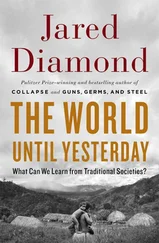Jared Diamond - Guns, Germs & Steel
Здесь есть возможность читать онлайн «Jared Diamond - Guns, Germs & Steel» весь текст электронной книги совершенно бесплатно (целиком полную версию без сокращений). В некоторых случаях можно слушать аудио, скачать через торрент в формате fb2 и присутствует краткое содержание. Жанр: 105. Описание произведения, (предисловие) а так же отзывы посетителей доступны на портале библиотеки ЛибКат.
- Название:Guns, Germs & Steel
- Автор:
- Жанр:
- Год:неизвестен
- ISBN:нет данных
- Рейтинг книги:5 / 5. Голосов: 1
-
Избранное:Добавить в избранное
- Отзывы:
-
Ваша оценка:
- 100
- 1
- 2
- 3
- 4
- 5
Guns, Germs & Steel: краткое содержание, описание и аннотация
Предлагаем к чтению аннотацию, описание, краткое содержание или предисловие (зависит от того, что написал сам автор книги «Guns, Germs & Steel»). Если вы не нашли необходимую информацию о книге — напишите в комментариях, мы постараемся отыскать её.
Guns, Germs & Steel — читать онлайн бесплатно полную книгу (весь текст) целиком
Ниже представлен текст книги, разбитый по страницам. Система сохранения места последней прочитанной страницы, позволяет с удобством читать онлайн бесплатно книгу «Guns, Germs & Steel», без необходимости каждый раз заново искать на чём Вы остановились. Поставьте закладку, и сможете в любой момент перейти на страницу, на которой закончили чтение.
Интервал:
Закладка:
HOW AFRICA BECAME BLACK • 399
It's true, of course, that some large African animals have occasionally been tamed. Hannibal enlisted tamed African elephants in his unsuccessful war against Rome, and ancient Egyptians may have tamed giraffes and other species. But none of those tamed animals was actually domesticated—that is, selectively bred in captivity and genetically modified so as to become more useful to humans. Had Africa's rhinos and hippos been domesticated and ridden, they would not only have fed armies but also have provided an unstoppable cavalry to cut through the ranks of European horsemen. Rhino-mounted Bantu shock troops could have overthrown the Roman Empire. It never happened.
A second factor is a corresponding, though less extreme, disparity between sub-Saharan Africa and Eurasia in domesticable plants. The Sahel, Ethiopia, and West Africa did yield indigenous crops, but many fewer varieties than grew in Eurasia. Because of the limited variety of wild starting material suitable for plant domestication, even Africa's earliest agriculture may have begun several thousand years later than that of the Fertile Crescent.
Thus, as far as plant and animal domestication was concerned, the head start and high diversity lay with Eurasia, not with Africa. A third factor is that Africa's area is only about half that of Eurasia. Furthermore, only about one-third of its area falls within the sub-Saharan zone north of the equator that was occupied by farmers and herders before 1000 b.c. Today, the total population of Africa is less than 700 million, compared with 4 billion for Eurasia. But, all other things being equal, more land and more people mean more competing societies and inventions, hence a faster pace of development.
The remaining factor behind Africa's slower rate of post-Pleistocene development compared with Eurasia's is the different orientation of the main axes of these continents. Like that of the Americas, Africa's major axis is north-south, whereas Eurasia's is east-west (Figure 10.1). As one moves along a north-south axis, one traverses zones differing greatly in climate, habitat, rainfall, day length, and diseases of crops and livestock. Hence crops and animals domesticated or acquired in one part of Africa had great difficulty in moving to other parts. In contrast, crops and animals moved easily between Eurasian societies thousands of miles apart but at the same latitude and sharing similar climates and day lengths.
The slow passage or complete halt of crops and livestock along Africa's north-south axis had important consequences. For example, the Mediter-
400 • GUNS, GERMS, AND STEEL
ranean crops that became Egypt's staples require winter rains and seasonal variation in day length for their germination. Those crops were unable to spread south of the Sudan, beyond which they encountered summer rains and little or no seasonal variation in daylight. Egypt's wheat and barley never reached the Mediterranean climate at the Cape of Good Hope until European colonists brought them in 1652, and the Khoisan never developed agriculture. Similarly, the Sahel crops adapted to summer rain and to little or no seasonal variation in day length were brought by the Bantu into southern Africa but could not grow at the Cape itself, thereby halting the advance of Bantu agriculture. Bananas and other tropical Asian crops for which Africa's climate is eminently suitable, and which today are among the most productive staples of tropical African agriculture, were unable to reach Africa by land routes. They apparently did not arrive until the first millennium a.d., long after their domestication in Asia, because they had to wait for large-scale boat traffic across the Indian Ocean.
Africa's north-south axis also seriously impeded the spread of livestock. Equatorial Africa's tsetse flies, carrying trypanosomes to which native African wild mammals are resistant, proved devastating to introduced Eurasian and North African species of livestock. The cows that the Bantu acquired from the tsetse-free Sahel zone failed to survive the Bantu expansion through the equatorial forest. Although horses had already reached Egypt around 1800 b.c. and transformed North African warfare soon thereafter, they did not cross the Sahara to drive the rise of cavalry-mounted West African kingdoms until the first millennium a.d., and they never spread south through the tsetse fly zone. While cattle, sheep, and goats had already reached the northern edge of the Serengeti in the third millennium b.c., it took more than 2,000 years beyond that for livestock to cross the Serengeti and reach southern Africa.
Similarly slow in spreading down Africa's north-south axis was human technology. Pottery, recorded in the Sudan and Sahara around 8000 b.c., did not reach the Cape until around a.d. 1. Although writing developed in Egypt by 3000 b.c. and spread in an alphabetized form to the Nubian kingdom of Meroe, and although alphabetic writing reached Ethiopia (possibly from Arabia), writing did not arise independently in the rest of Africa, where it was instead brought in from the outside by Arabs and Europeans.
In short, Europe's colonization of Africa had nothing to do with differ-
HOW AFRICA BECAME BLACK • 401
ences between European and African peoples themselves, as white racists assume. Rather, it was due to accidents of geography and biogeography— in particular, to the continents' different areas, axes, and suites of wild plant and animal species. That is, the different historical trajectories of Africa and Europe stem ultimately from differences in real estate.
YALl'S QUESTION WENT TO THE HEART OF THE CURRENT human condition, and of post-Pleistocene human history. Now that we have completed this brief tour over the continents, how shall we answer Yali?
I would say to Yali: the striking differences between the long-term histories of peoples of the different continents have been due not to innate differences in the peoples themselves but to differences in their environments. I expect that if the populations of Aboriginal Australia and Eurasia could have been interchanged during the Late Pleistocene, the original Aboriginal Australians would now be the ones occupying most of the Americas and Australia, as well as Eurasia, while the original Aboriginal Eurasians would be the ones now reduced to downtrodden population fragments in Australia. One might at first be inclined to dismiss this assertion as meaningless, because the experiment is imaginary and my claim about its outcome cannot be verified. But historians are nevertheless able to evaluate related hypotheses by retrospective tests. For instance, one can examine what did happen when European farmers were transplanted to Greenland or the U.S. Great Plains, and when farmers stemming ultimately from China emigrated to the Chatham Islands, the rain forests of Borneo, or the volcanic soils of Java or Hawaii. These tests confirm that the same
4 O 6 * EPILOGUE
ancestral peoples either ended up extinct, or returned to living as hunter-gatherers, or went on to build complex states, depending on their environments. Similarly, Aboriginal Australian hunter-gatherers, variously transplanted to Flinders Island, Tasmania, or southeastern Australia, ended up extinct, or as hunter-gatherers with the modern world's simplest technology, or as canal builders intensively managing a productive fishery, depending on their environments.
Of course, the continents differ in innumerable environmental features affecting trajectories of human societies. But a mere laundry list of every possible difference does not constitute an answer to Yali's question. Just four sets of differences appear to me to be the most important ones.
The first set consists of continental differences in the wild plant and animal species available as starting materials for domestication. That's because food production was critical for the accumulation of food surpluses that could feed non-food-producing specialists, and for the buildup of large populations enjoying a military advantage through mere numbers even before they had developed any technological or political advantage. For both of those reasons, all developments of economically complex, socially stratified, politically centralized societies beyond the level of small nascent chiefdoms were based on food production.
But most wild animal and plant species have proved unsuitable for domestication: food production has been based on relatively few species of livestock and crops. It turns out that the number of wild candidate species for domestication varied greatly among the continents, because of differences in continental areas and also (in the case of big mammals) in Late Pleistocene extinctions. These extinctions were much more severe in Australia and the Americas than in Eurasia or Africa. As a result, Africa ended up biologically somewhat less well endowed than the much larger Eurasia, the Americas still less so, and Australia even less so, as did Yali's New Guinea (with one-seventieth of Eurasia's area and with all of its original big mammals extinct in the Late Pleistocene).
On each continent, animal and plant domestication was concentrated in a few especially favorable homelands accounting for only a small fraction of the continent's total area. In the case of technological innovations and political institutions as well, most societies acquire much more from other societies than they invent themselves. Thus, diffusion and migration within a continent contribute importantly to the development of its societies, which tend in the long run to share each other's developments (insofar
Интервал:
Закладка:
Похожие книги на «Guns, Germs & Steel»
Представляем Вашему вниманию похожие книги на «Guns, Germs & Steel» списком для выбора. Мы отобрали схожую по названию и смыслу литературу в надежде предоставить читателям больше вариантов отыскать новые, интересные, ещё непрочитанные произведения.
Обсуждение, отзывы о книге «Guns, Germs & Steel» и просто собственные мнения читателей. Оставьте ваши комментарии, напишите, что Вы думаете о произведении, его смысле или главных героях. Укажите что конкретно понравилось, а что нет, и почему Вы так считаете.










